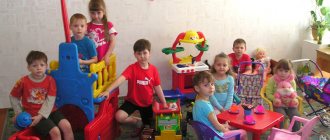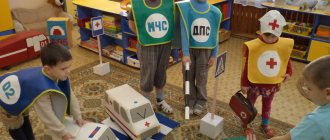Construction in kindergarten
| According to the terms | In the process of such construction, children develop the ability to analyze conditions and, on the basis of this analysis, build practical activities of a rather complex structure. Children just as easily and firmly learn the dependence of the structure of a structure on its practical purpose and in the future can themselves - based on the establishment of such a dependence - determine the specific conditions to which their construction will correspond, create interesting ideas and implement them |
| By design | Creating a plan for a future design and its implementation is a rather difficult task for preschoolers: their plans are unstable and often change in the process of activity. It is necessary to develop the desire to build according to your own plans, combine buildings according to the plot, play with them, encourage them to play together |
| On this topic | Children are offered a general design theme (“Birds”, “City”, etc.), and they themselves create plans for specific buildings, crafts, choose the material and methods of their implementation |
Tasks in teaching and guiding children's constructive activities
:
To develop in children the necessary skills and design skills.
To give children knowledge about objects displayed in constructive activities, about their appearance, structure, main parts, shape, spatial arrangement, relative size, about the materials with which they work.
Children should be able to group objects according to their common characteristics and understand the relationship between the features of their shape and the functions they perform.
Determine the texture of paper (whatman paper, glossy color, writing), know thin cardboard, wire in an insulating winding, etc. Know their properties and possibilities of use. Children should be able to use paste, stationery and wood glue when gluing various materials.
Teach children to work purposefully and pre-plan their activities, which is a necessary condition for the successful completion of constructive tasks.
To foster in children independence in work and creative initiative.
To develop the ability to control one’s activities, to direct it towards a more rational path to solving the problem proposed by the teacher. To teach to understand that the purpose of design classes is not so much a practical result as the acquisition of new knowledge and skills, that is, to develop in children the ability to learn and readiness to study at school.
It is also necessary to use the rich opportunities for constructive activities to instill in children a sense of teamwork at work.
Basic techniques for teaching design
Card index of topics
When choosing a topic, the teacher takes into account the time of year, public holidays and other important events in people's lives.
A topic index might look like this:
- “Autumn Forest”: mushrooms, trees, animals, etc.;
- “Favorite fairy tale characters”: bun, hare, pig, bird;
- “My city”: houses, gates around them, streets, traffic lights;
- “My Home”: creation of one- and multi-story houses;
- “Winter”: Christmas tree, bullfinch, snowflake, snowman;
- “New Year”: New Year cards, Santa Claus sticks;
- “February 14”: valentines, paper hearts;
- “February 23”: gifts for dads;
- “Transport”: cars of different types;
- “Furniture”: sofa, bed, armchair, etc.;
- “March 8”: gifts for mothers;
- "Children's Day": paper toys.
The wonderful influence of Lego on a child's development
In this regard, the story of my friends’ son is very indicative. The boy lagged behind his peers, including in terms of abilities. Even completing assignments in kindergarten was difficult for him. He didn't want to write and draw, sculpt and take tests. Everything caused furious protest!
And then his wise dad bought his son several construction sets. It was both traditional Lego and new, more complex variations on the theme. Dad and son designed together, and they were fascinated by the activity!
After some time, the boy became more diligent and began to show interest in mathematics. He knew very well how to make a model following the instructions. Moreover, I began to come up with my own models! By the first grade, it became clear that he was a smart, quick-witted child with a well-developed imagination.
Facts and Research
Interesting fact. At the end of the nineteenth century, very realistic construction sets that recreated houses began to be produced in Germany. It was called Anker-Steinbaukasten. These were “stone” blocks made from a mixture of chalk and quartz.
From them you could collect copies of buildings, or come up with your own versions. This is exactly the kind of designer Max Born, Albert Einstein, and Robert Oppenheimer had. And these people cannot be denied a lack of imagination, do you agree?
Numerous studies by scientists confirm that methods and techniques based on construction perfectly develop not only the imagination. This list also includes: fine motor skills, mathematical abilities, independence, speech, logic. And most importantly - interest in creating new things, and creativity!
Features of Fine Modeling
It is worth saying that most often in visual constructive-modeling activities in the older group, preschoolers achieve striking similarities with the object of modeling. If the final goal is intended for practical use, then the child pays much less attention to the process and construction. In this case, the main thing for preschoolers and schoolchildren is the presence of the qualities necessary for the game in the final result. For example, during the game it was necessary to fly on an airplane, so, in the child’s opinion, the important things were the wings, the steering wheel and the seat. The appearance of the model fades into the background: if the object satisfies the basic needs of games, then it is quite suitable. Things are completely different if a child, for example, sets himself the task of showing the differences between types of flying machines. In this case, constructive-modeling activities in the senior group are honed with special diligence. We can conclude that the quality of the final result depends, rather, on the desire of the child, and not on his skills. The presence of technical and visual types of design, which have their own characteristics, requires careful selection and study of cases in which they can be used.
You may be interested in: History of Vologda: foundation of the city, bridges, streets, monuments, photos
Construction as a development stimulus for a child
Construction really helps solve some problems and gaps in development. It will also help to discover numerous talents, including developing imagination and creative qualities. The most important condition for this is the game!
Design should not become a duty, a responsibility, a lesson. This game is an ideal activity, interesting and not boring for both children and adults.
It is extremely important that children have access to a wide variety of construction toys. The more there are, the more possible options, the wider the field for imagination. By constructing, a person constantly improves his thought processes, his imagination, fantasy, and creativity.
Side effects of construction
During educational activities, children from the middle and preparatory groups of kindergarten develop not only technical skills, but also the ability to analyze the reality around them, the formation of general ideas about the various objects they model begins, independent thinking, a craving for creativity, and artistic taste develop. The child is formed as a personality.
There are two most important stages in design: working on an idea and bringing it to life. Working on an idea is most often a creative process, since it involves thinking about it and calculating possible ways of implementation. Also, creative activity consists in determining the final result, methods and sequence of its achievement.
Practice in executing an idea cannot be entirely executional - design activity, even among older schoolchildren, combines both thought and practice.
If we talk about construction in preschoolers, the interaction of practice and thought can be called one of its strengths. At the same time, practical activity does not necessarily have to be close to certain canons - one can also experiment, as stated in the pedagogical works of L. A. Paramonova and G. V. Uradovskikh. The initial idea, in turn, is regularly refined and changed as a result of the application of various practical methods, which has a positive effect on the development of further creative design. Often, children reason out loud, pronouncing their actions and getting closer to the final result.
The benefits of construction for children
Almost all children and almost all adults love to design. It’s just that not everyone admits it! Modern psychologists believe that the love of design is inherent in us as an instinct.
Designers give us, first of all, the development of imagination and creative thinking.
The peculiarity of construction kits is that they usually come with assembly diagrams and instructions. And this, oddly enough, is not always good. But even assembly instructions do not prevent children from developing!
Very soon they get tired of following the schemes, and their imagination and fantasy burst out! Children get creative and come up with their own, sometimes very strange and unusual, objects.
Along the way, they create new things, create, analyze, plan, and act consistently. All this is extremely important for their life as well as their studies.
Influence of designers:
- they provide spatial imagination;
- the ability to understand the properties of geometric shapes;
- help to understand concepts such as shape, size;
- develop imagination, creativity, creativity;
- help to use directions;
- and, finally, they develop independence, perseverance, and hard work - without this, even the most vivid imagination will not result in a worthy result.
What to do when you grow up
Construction sets are useful for children.
Sometimes it even affects their future. What to do if you lack design skills after 18? We have collected several tips that have been tested by ourselves, time and Giktayms. Play with children.
This is a pain-free way to try out a bunch of construction kits. By the way, they say that construction is a good prevention of Alzheimer’s disease.
Start a hobby.
Apple engineer Andrew Carroll made a working copy of the Antikythera Mechanism using Lego.
And you can’t say that you wasted your time.
Make a business.
This is an excellent design option with unpredictable results. You can even make your own construction set and sell it.
If you stay in the small business niche, we have come up with a website builder for you.
Design websites.
The good thing about this option is that with the current level of technology development it is suitable for many - knowing HTML is no longer necessary.
Start Arduino.
This method is described on Giktayms on average once a day.
Be nostalgic.
When we did a survey within the company, people recalled how they kept and passed on children’s construction sets, made things out of sticks and ropes, and... how “every thing, after disassembling, turned into a construction set.”
Main types of construction sets for children
- Cubes are a real “classic”, a primitive but effective construction set for kids. It introduces shape, color, texture. And it makes it possible to come up with your own models, albeit primitive ones.
- Inserts help to learn how to compare the shapes and sizes of elements, but practically do not develop imagination.
- Mosaic - develops imaginative thinking, because from it you can assemble your own, real picture!
- Block type constructors. You can create anything from these, give free rein to your imagination! You can make houses, airplanes, rockets, whatever!
- Lego is the maximum advantage of a regular construction set, plus the possibility of more complex 3D modeling, consisting of hundreds and thousands of parts. There are practically no limits to the imagination, because here you can make any fantasy come true!
By the way, it is free design (without instructions, tips and diagrams) that opens up the opportunity for children and adults to think outside the box. And also - give free rein to your imagination, fantasize from the heart.
That's all! Develop your imagination and other important skills. And design for your own pleasure, no matter whether you are a child or an adult. Be sure to subscribe to updates on this channel to receive even more important, useful information.
Comments here are also very welcome. If you think this article might be useful to your friends, please share it on social networks. Good luck to you!








